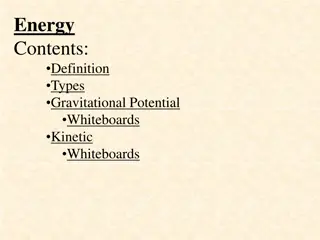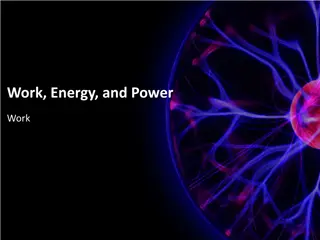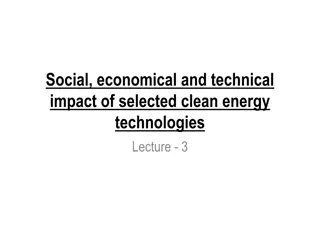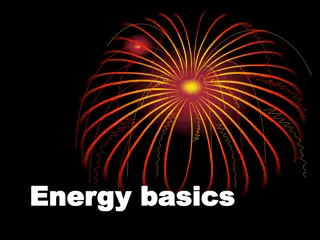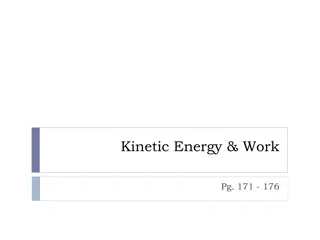Work and Energy
Fundamentals of work and energy, including defining work, calculating net work, identifying forms of energy, determining kinetic energy, and applying relevant theorems. Understand the relationship between force, displacement, and energy in various scenarios.
Download Presentation

Please find below an Image/Link to download the presentation.
The content on the website is provided AS IS for your information and personal use only. It may not be sold, licensed, or shared on other websites without obtaining consent from the author.If you encounter any issues during the download, it is possible that the publisher has removed the file from their server.
You are allowed to download the files provided on this website for personal or commercial use, subject to the condition that they are used lawfully. All files are the property of their respective owners.
The content on the website is provided AS IS for your information and personal use only. It may not be sold, licensed, or shared on other websites without obtaining consent from the author.
E N D
Presentation Transcript
WORK: SECTION ONE WORK: SECTION ONE Section Objectives: Define work by relating it to force and displacement. Identify where work is being performed in a variety of situations. Calculate the net work done when many forces are applied to an object.
When is work done on an object? Work is done when a force causes a displacement of the object, and when components of a force are parallel to displacement. Work = Force x Distance (W=Fxd) The product of the component of a force along the direction of displacement and the magnitude of the displacement. W=Fdcos , Wnet=Fnetdcos W=Nxm or Joules
SAMPLE PROBLEM A: WORK SAMPLE PROBLEM A: WORK How much work is done on a vacuum cleaner pulled 3.0-m by a force of 50.0-N at an angle of 30 above the horizontal? Knowns: d=3.0-m, F=50.0-N, =30 Unknown: W=? Formula:_____________?
IS WORK A SCALAR OR A VECTOR IS WORK A SCALAR OR A VECTOR QUANTITY? WHEN IS WORK QUANTITY? WHEN IS WORK POSITIVE? POSITIVE? Work is a scalar quantity so it can be positive or negative. Work is positive when the component of force is in the same direction as the displacement. It is negative when the force is in the opposite direction of the displacement. Cos is negative for angles greater than 90 , but less than 270 .
SECTION 2: ENERGY SECTION 2: ENERGY Objectives: Identify several forms of energy. Calculate kinetic energy for an object. Apply the work-kinetic energy theorem to solve problems. Distinguish between kinetic and potential energy. Classify different types of potential energy. Calculate the potential energy associated with an object s position.
KINETIC ENERGY KINETIC ENERGY- -THE ENERGY OF AN OBJECT THE ENERGY OF AN OBJECT DUE TO ITS MOTION. IT DEPENDS ON SPEED DUE TO ITS MOTION. IT DEPENDS ON SPEED AND MASS; SCALAR. AND MASS; SCALAR. KE=1/2mv2 Wnet=F X=ma X *For an object under constant acceleration, vf2=vi2+2a X Wnet=m(vf2-vi2)/2 Wnet=1/2mvf2-1/2mvi2
SAMPLE PROBLEM B: KINETIC SAMPLE PROBLEM B: KINETIC ENERGY ENERGY A 7.0-kg bowling ball moves at 3.0-m/s. How fast must a 2.45-g table tennis ball move in order to have the same kinetic energy as the bowling ball? Is this speed reasonable for a table tennis ball in play? Knowns: mb=7.0-kg, mt=2.45-g, vb=3.0-m/s Unknown: vt
THE NET WORK DONE ON A BODY THE NET WORK DONE ON A BODY EQUALS ITS CHANGE IN KINETIC EQUALS ITS CHANGE IN KINETIC ENERGY. THIS IS THE WORK ENERGY. THIS IS THE WORK- -KINETIC ENERGY THEOREM. ENERGY THEOREM. KINETIC Wnet= KE
On a frozen pond, a person kicks a 10.0-kg sled, giving it an initial speed of 2.2-m/s. How far does the sled move if the coefficient of kinetic friction between the sled and the ice is 0.10? Known: m=10.0-kg, vi=2.2-m/s, vf=0-m/s, k=0.10 Unknown: d=? SAMPLE PROBLEM C: WORK SAMPLE PROBLEM C: WORK- - KINETIC ENERGY THEOREM KINETIC ENERGY THEOREM
Potential Energy-the energy of an object due to its position, shape, or condition. Gravitational potential energy-the energy of an object due to its position relative to a gravitational source. Peg=mgh (h=height) Elastic potential energy-the energy available for use when a deformed elastic object returns to its original configuration, compressed or stretched. Peelastic=1/2kx2
SAMPLE PROBLEM D: POTENTIAL SAMPLE PROBLEM D: POTENTIAL ENERGY ENERGY A 70.0-kg stuntman is attached to a bungee cord with an unstretched length of 15.0-m. He jumps off a bridge spanning a river from a height of 50.0- m. When he finally stops, the cord has a stretched length of 44.0-m. Treat the stuntman as a point mass, and disregard the weight of the bungee cord. Assuming the spring constant (k) of the bungee cord is 71.8-N/m, what is the total potential energy relative to the water when the man stops falling?
Section Objectives: Identify situations in which conservation of mechanical energy is valid. Recognize the forms that conserved energy can take. Solve problems using conservation of mechanical energy. SECTION 3: SECTION 3: CONSERVATION OF CONSERVATION OF ENERGY ENERGY
If something is conserved, it remains constant. Mechanical energy is the sum of kinetic energy and all the forms of potential energy. Energy conservation occurs when acceleration varies. ME=KE + ME=KE + PE PE
Mechanical Energy is often conserved. Mei=Mef Energy Mechanical Kinetic Mechanical PE gravitational PE elastic Non- mechanical All other forms
1/2mvi2+ mghi= 1/2mvf2+ mghf Starting from rest, a child zooms down a frictionless slide from an initial height of 3.00-m. What is her speed at the bottom of the slide? Assume she has a mass of 25.0-kg. Known: hi=3.0-m, m=25.0-kg, vi=0-m/s, hf=0-m Unknown: vf=? SAMPLE PROBLEM E: CONSERVATION OF SAMPLE PROBLEM E: CONSERVATION OF MECHANICAL ENERGY MECHANICAL ENERGY
Section Objectives: Relate the concepts energy, time, and power. Calculate power in two different ways. Explain the effect of machines on work and power. SECTION 4: POWER SECTION 4: POWER
P=W/t, W=Fd, P=Fv The SI unit of power is the watt, W. One watt is equal to one Joule per second. Power is the rate at which work is Power is the rate at which work is done or the rate of energy done or the rate of energy transfer. transfer.
A 193.0-kg curtain needs to be raised 7.5-m, at constant speed, in as close to 5.0-s as possible. The power ratings for three motors are listed as 1.0-kW, 3.5-kW, and 5.5-kW. Which motor is best for the job? Known: m=193-kg, t=5.0-s, d=7.5-m Unknown: P=? SAMPLE PROBLEM F: SAMPLE PROBLEM F: POWER POWER




